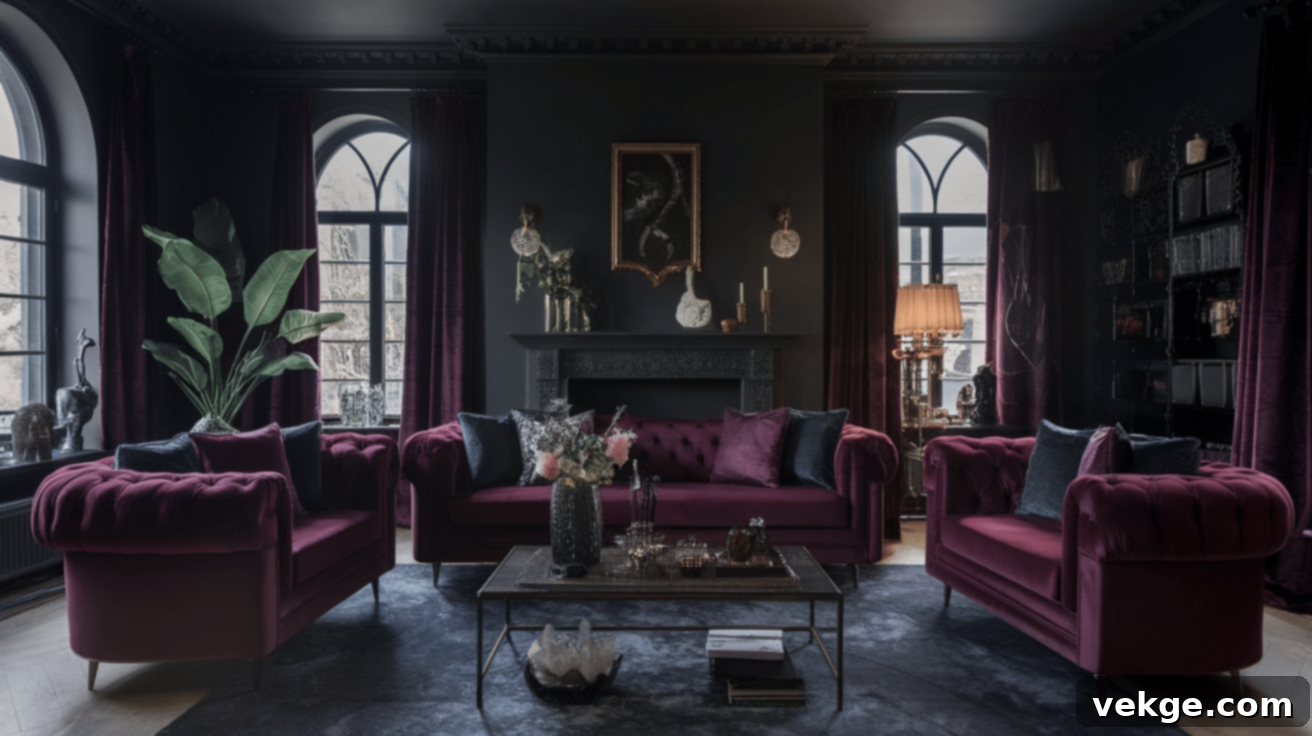Create Your Dream Modern Gothic Living Room: Ultimate Design Ideas & Tips
Modern Gothic design offers a perfect balance of darkness and comfort for those who want a living space with distinctive character and a touch of drama. Unlike its historical origins, which might conjure images of gloomy castles, today’s gothic style elegantly blends deep, rich colors, intricate patterns, and moody accents with the comfort and functionality of contemporary living. The result is a home that feels both grand and inviting, a true sanctuary that expresses a unique aesthetic.
The essence of modern gothic lies in a thoughtful mix of black, deep purples, rich reds, and forest greens, often accented with metallic touches like gold or silver, without making your space feel overwhelming or melancholic. It’s about creating an atmosphere that is sophisticated, a little mysterious, and undeniably cozy. In this comprehensive guide, we will explore a variety of ideas and practical tips that will help you design a modern gothic living room that perfectly suits your taste and transforms your house into a captivating home. Get ready to embrace the enchanting allure of modern gothic design!
Key Features of Modern Gothic Living Rooms
Modern gothic living rooms are characterized by a compelling blend of old-world charm and sleek, clean lines. This style embraces a rich palette of deep colors, which are fundamental to setting the desired mood. Think profound blacks, luxurious purples, and passionate reds as the foundation, often complemented by deep blues or emerald greens. Furniture often features carved details or elegant silhouettes that evoke a sense of history without feeling dated. These pieces add character and a touch of aristocratic elegance to the space.
Lighting is a crucial element, playing a pivotal role in shaping the room’s atmosphere. Instead of harsh, bright lights, modern gothic favors softer, more diffused sources like flickering candles, artfully placed wall sconces, or grand chandeliers equipped with dimmable bulbs. This layering of light creates dramatic shadows and warm, inviting glows. Seating upholstered in plush velvet or supple leather not only brings comfort but also enhances the opulent and stylish feel. The most successful modern gothic rooms strike a delicate balance between dark and light, perhaps featuring pale walls that highlight dark, imposing furniture, or vice versa, to prevent the space from feeling too heavy. Finally, personal items, a curated collection of books, and cherished decor transform the room from a mere display into a lived-in, soulful space that tells a story.
Inspiring Ideas for a Modern Gothic Living Room
When planning a gothic-inspired living room, don’t shy away from bold choices, but always keep the space’s livability in mind. Modern gothic design doesn’t have to feel like a relic from the past or a cold, uninviting space. On the contrary, it can be wonderfully warm and deeply inviting while still honoring the dark, rich, and dramatic style that makes it so unique. The following ideas are carefully selected to help you create a space that masterfully balances darkness with light, intertwines old with new, and infuses drama with ultimate comfort.
1. Bold Black Walls
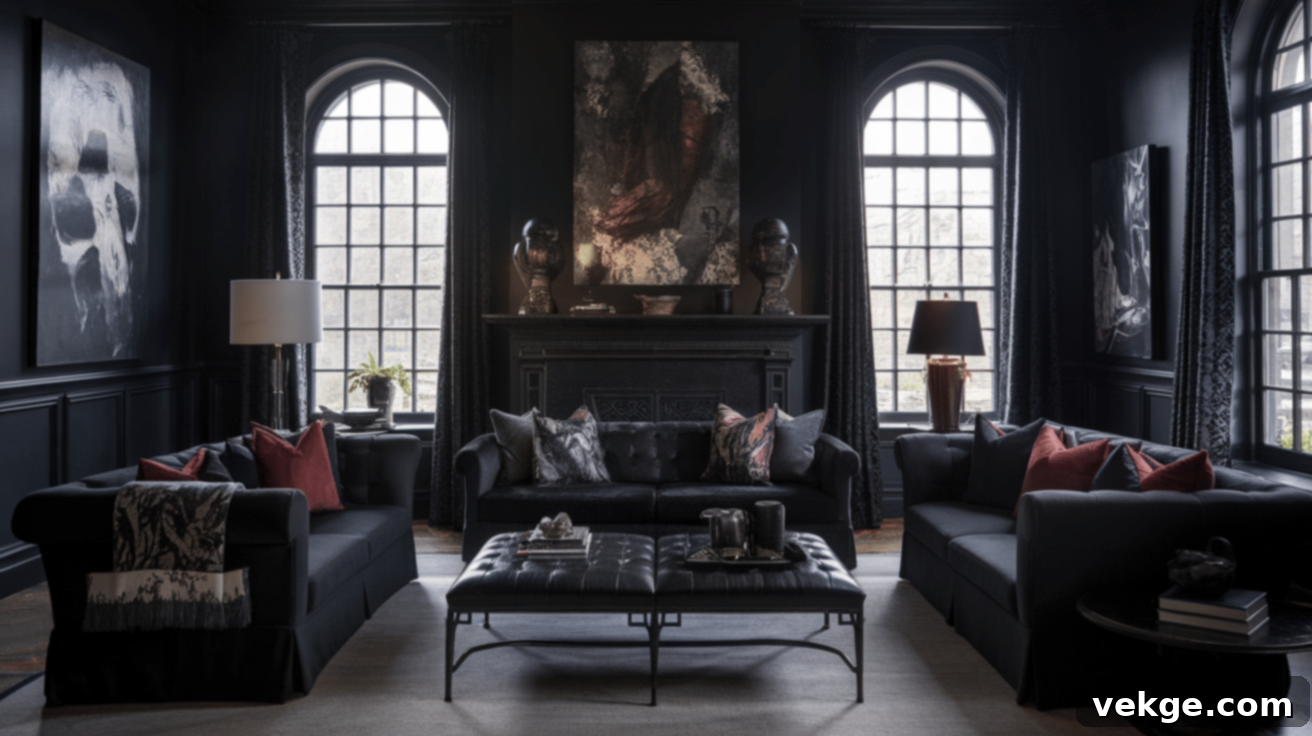
Black walls serve as an incredibly powerful and dramatic base for any gothic living room, instantly adding a profound sense of depth and a captivating mood to your space. Far from making a room feel gloomy, when paired thoughtfully with the right lighting and decor, black walls can create an incredibly cozy and intimate atmosphere, almost like a comforting embrace. They possess a unique ability to highlight artwork, making colors pop, and cause metallic finishes to gleam with an intensity that lighter colors simply cannot achieve. Consider a matte black for a sophisticated, velvety look, or a high-gloss black for a more reflective and modern edge. Always test swatches to see how natural light interacts with the shade throughout the day.
2. Incorporate Dark Jewel Tones
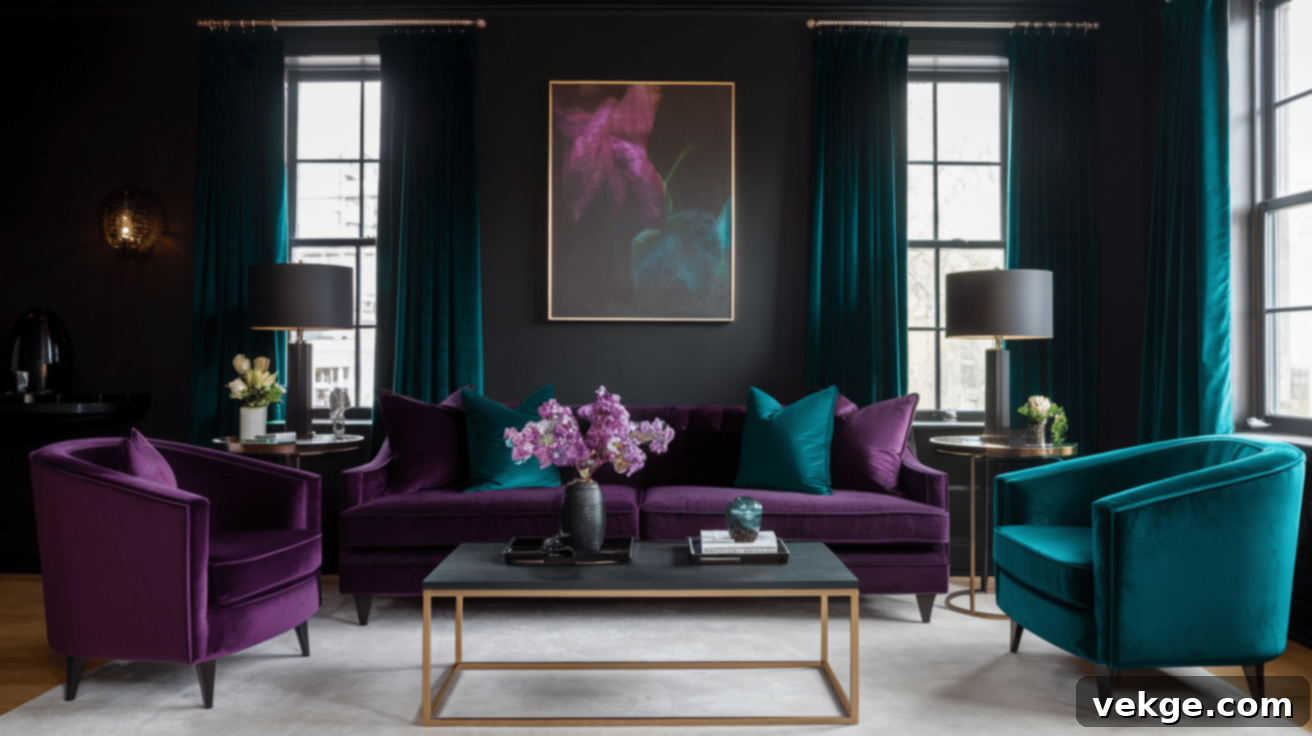
Dark jewel tones are essential for injecting vibrant life and opulent color into a gothic living room, preventing it from feeling monotone. Deep blues, rich purples, emerald greens, and even ruby reds work as perfect accent colors against dominant black or charcoal backgrounds. You can introduce these luxurious hues through plush velvet pillows, flowing satin or velvet curtains, or small, impactful furniture pieces like an upholstered ottoman or a statement armchair. These tones not only create visual depth and undeniable interest but also reflect light in a way that pure black cannot, adding a dynamic shimmer and warmth without making the room feel overwhelming.
3. Victorian-Inspired Velvet Sofas
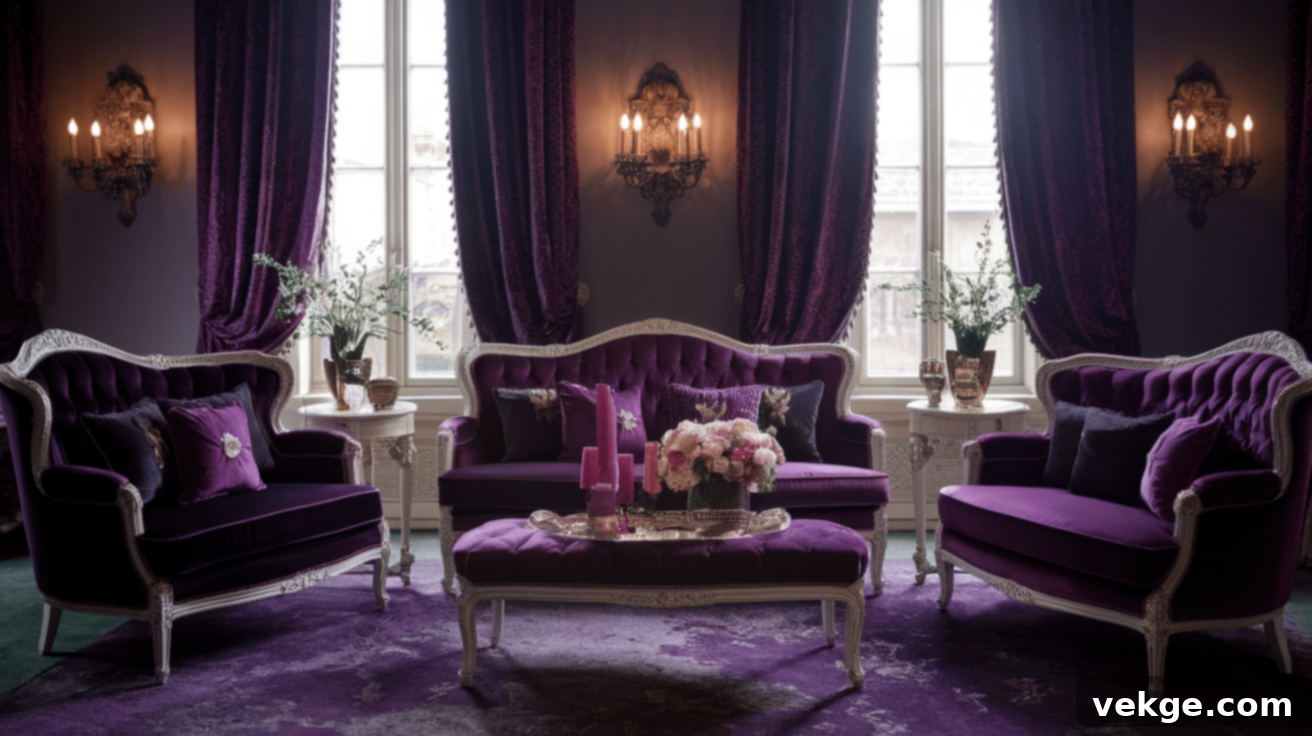
Velvet sofas in deep, rich colors are a hallmark of comfort and refined class in gothic living rooms. Seek out pieces with intricate carved wooden details on their legs or arms, or opt for sumptuous tufted backs that subtly nod to old-world Victorian grandeur. Shades like dark purple, classic black, or deep forest green velvet are particularly effective, as the material catches light in a soft, undulating way that adds incredible depth and visual texture to your room. These majestic sofas naturally become a central focal point, exuding an inviting aura that encourages guests to relax and linger.
4. Statement Chandeliers
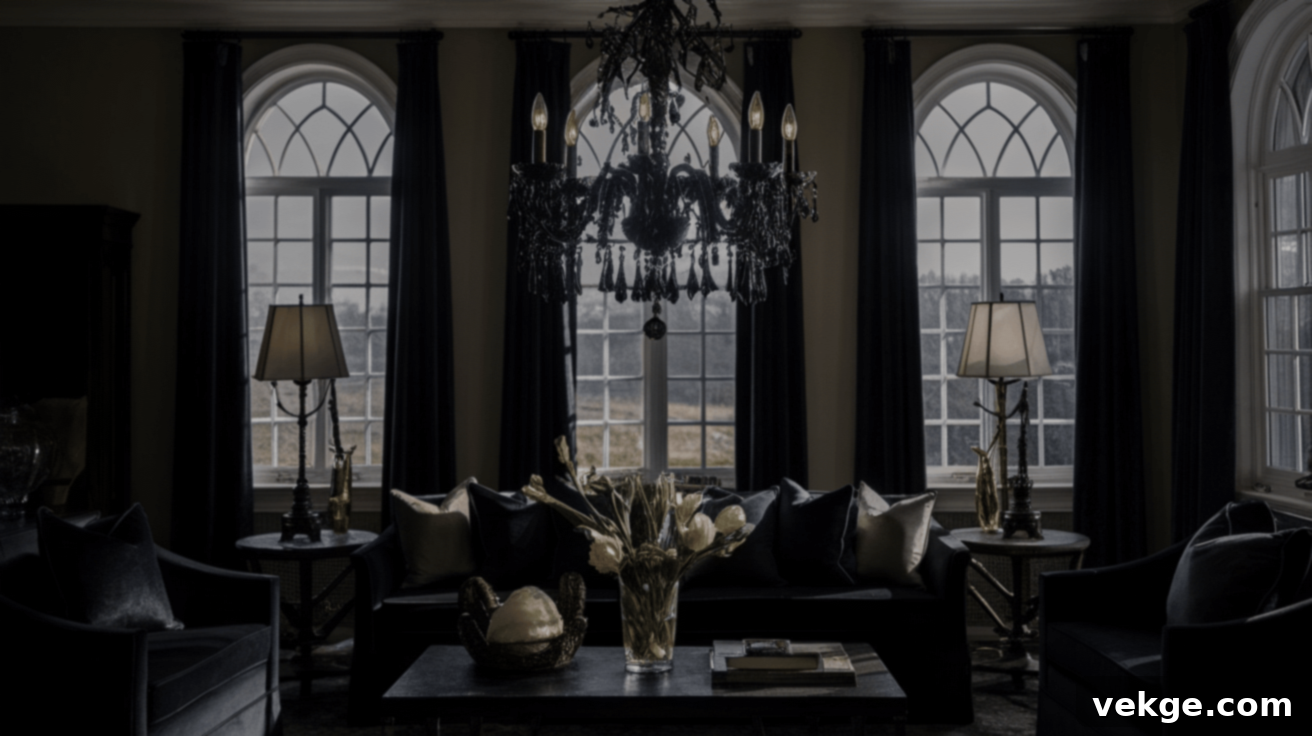
An ornate and impactful chandelier creates instant drama and an undeniable focal point in any gothic living room. Search for designs featuring black crystals, robust wrought iron, or candle-style lights that cast intriguing shadows and a warm glow. The right chandelier functions as both a primary light source and a striking piece of art, drawing the eye upwards and adding significant vertical interest to the space. Even in smaller rooms, a carefully chosen overhead fixture can completely transform the mood and elegantly tie together all your dark, dramatic design elements, adding a touch of theatrical splendor.
5. Use Intricate Mirrors
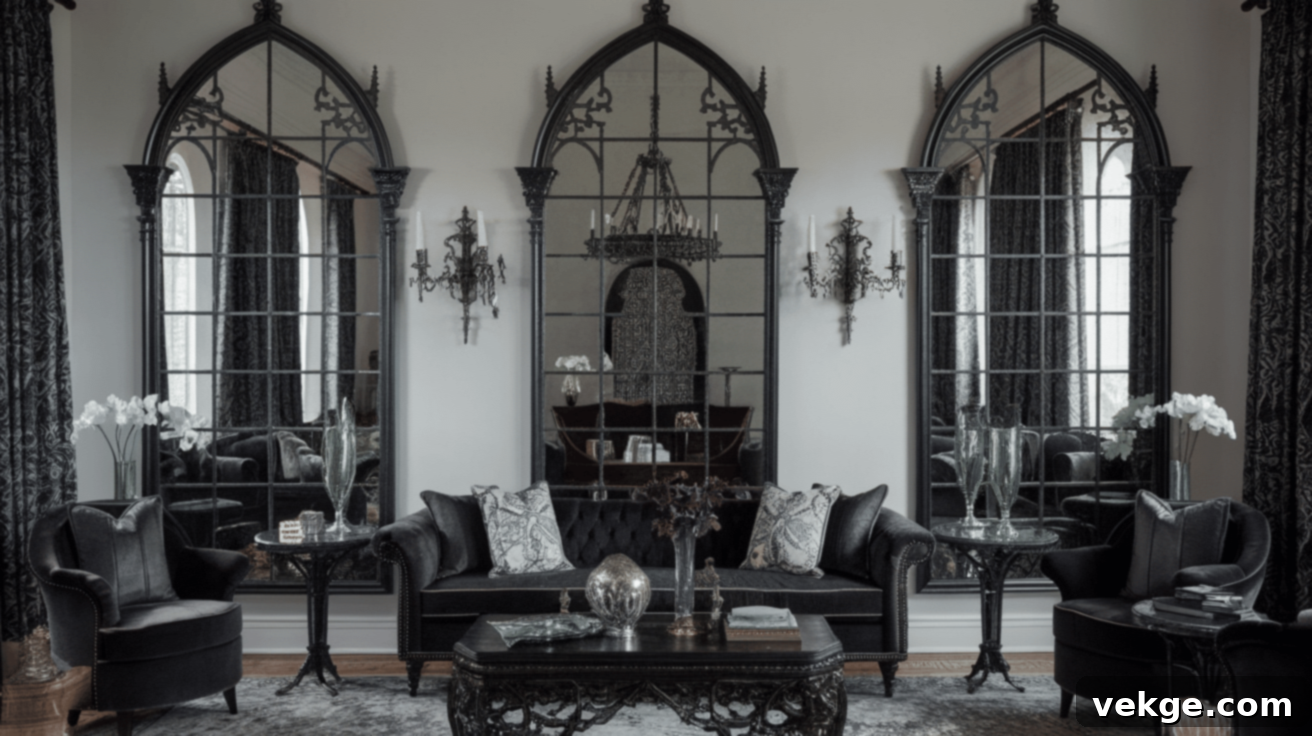
Ornate mirrors, especially those with elaborate black or metallic frames, are fantastic for enhancing any gothic space. Their complex patterns and shapes add rich visual interest, while their reflective surfaces simultaneously make rooms feel larger and brighter, a crucial aspect in often dark-hued gothic interiors. Strategically place a large mirror directly across from a window to maximize the natural light filtering into rooms with dark walls. Vintage or baroque-style mirrors with subtly aged glass bring an authentic, lived-in character that new pieces often struggle to replicate, creating depth and elegantly reflecting other gothic elements throughout the room.
6. Add Moody Lighting

The strategic use of soft, gentle lighting is paramount for creating the perfect moody ambiance in a gothic space. Think beyond overhead fixtures: candle-style lamps, elegant wall sconces with dimmable bulbs, and even subtle string lights can add a much-needed warmth to dark surroundings. Layering different light sources at various heights around the room is key to creating depth and visual interest. Floor lamps with dark fabric shades can cast a gentle, diffused glow that feels both cozy and wonderfully secretive. Thoughtful lighting prevents dark rooms from feeling gloomy or uninviting, ensuring they remain functional and captivating.
7. Gothic-Inspired Artwork

Dark, evocative art pieces are essential for setting the desired tone in a gothic living room. Seek out prints featuring classic gothic motifs such as skulls, ravens, ancient castles or ruins, or shadowy, ethereal forests. Vintage portraits with serious, contemplative expressions also work exceptionally well, adding a sense of history and mystery. Black frames create a clean, crisp contrast against dark walls, making the artwork truly stand out. You can group smaller pieces together for a powerful gallery wall effect, or choose one single, large statement piece to serve as your room’s main focal point. The right art selection effortlessly pulls together your entire gothic theme, telling a silent, captivating story.
8. Wooden Accents with a Dark Finish
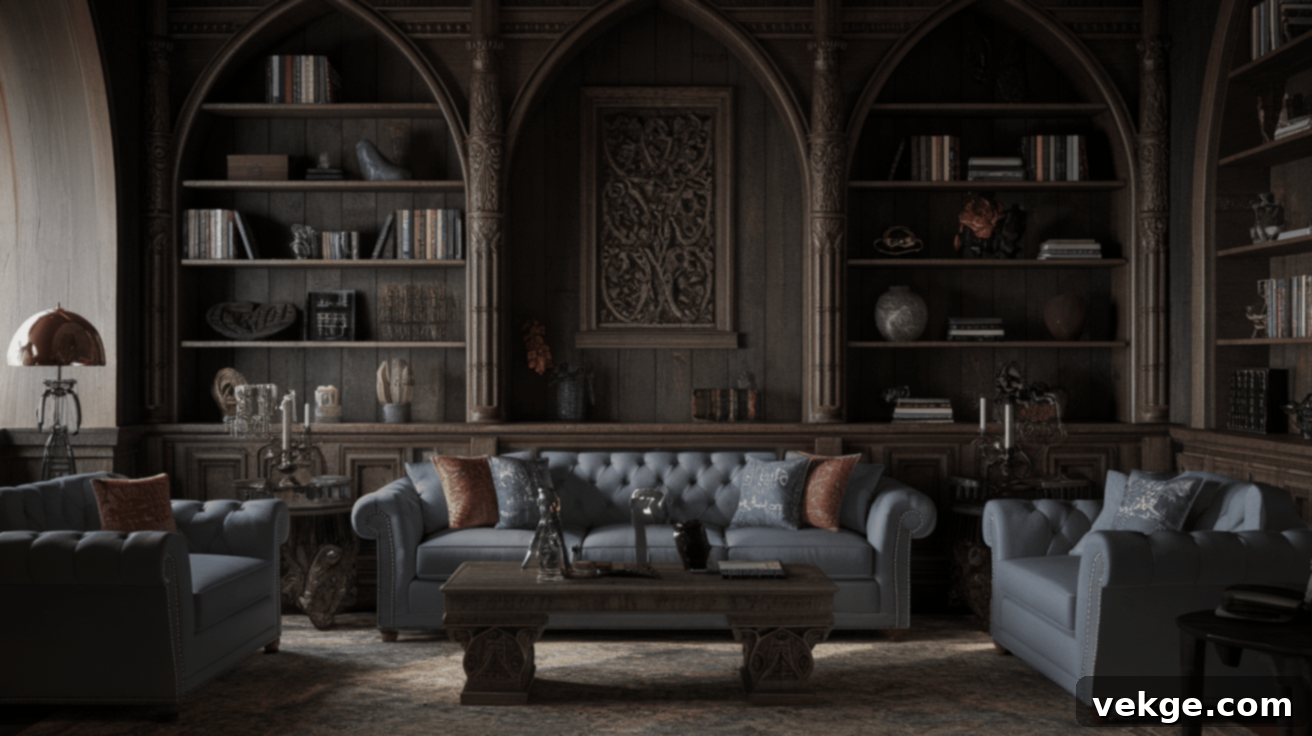
Introducing dark wood pieces is an excellent way to add organic warmth and grounding texture to a gothic living room. Look for side tables, sturdy bookshelves, and coffee tables crafted from deep mahogany, rich walnut, or ebony finishes. These wooden elements effectively break up the visual heaviness of black walls and dark fabrics, providing a natural counterpoint. Carved details, intricate inlays, or gothic-inspired leg shapes further enhance the theme without making the space feel flat or one-dimensional. Wood brings a natural, lived-in quality that beautifully balances the more formal and opulent aspects of the Gothic style, adding a touch of rustic elegance.
9. Dark Leather Furniture
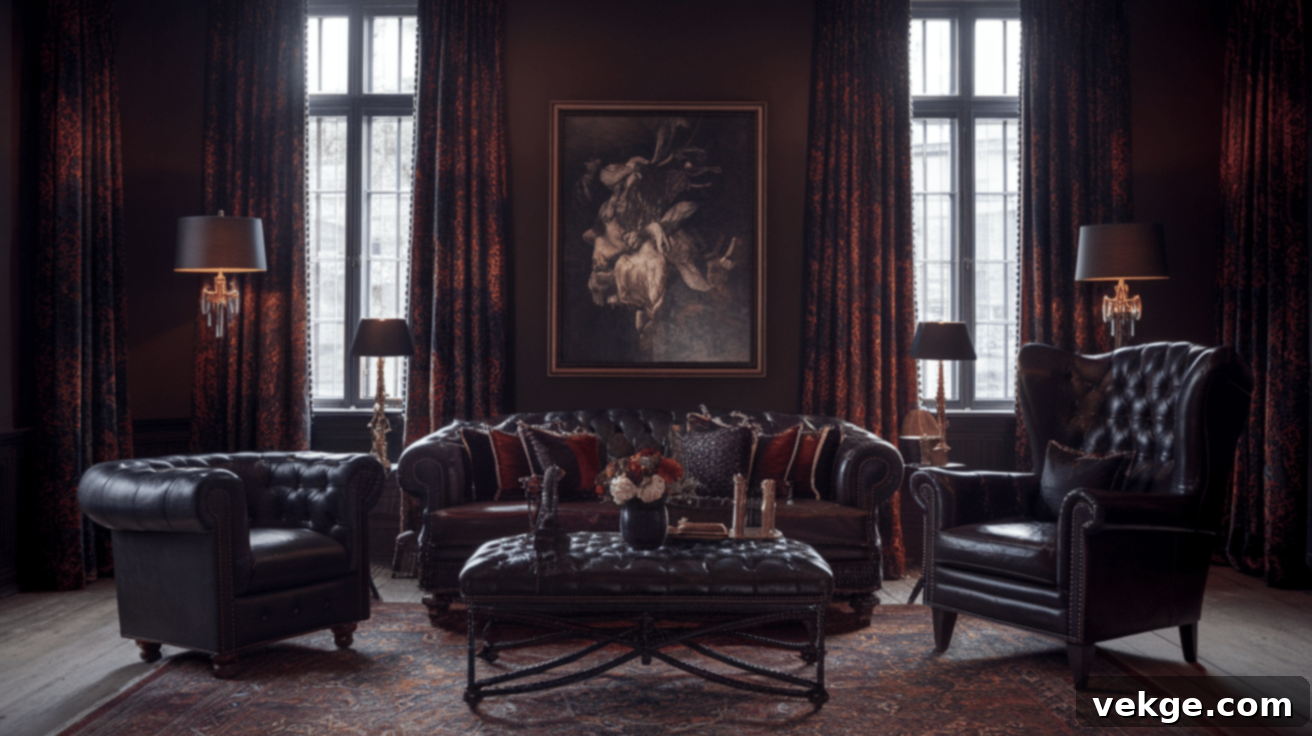
Leather pieces in deep shades of dark brown or classic black bring an unparalleled combination of comfort, durability, and sophisticated style to gothic living rooms. The smooth, often slightly worn texture of leather creates a delightful contrast against the plushness of velvet and other soft textiles. Worn or aged leather, in particular, only improves with time, developing a unique patina that adds profound character to your space. A sleek black leather armchair or a robust dark brown sofa feels both rugged and undeniably fancy at once, making these pieces versatile and suitable for both intimate and grand rooms, adding a timeless, strong presence.
10. Incorporate Gothic Decor Items
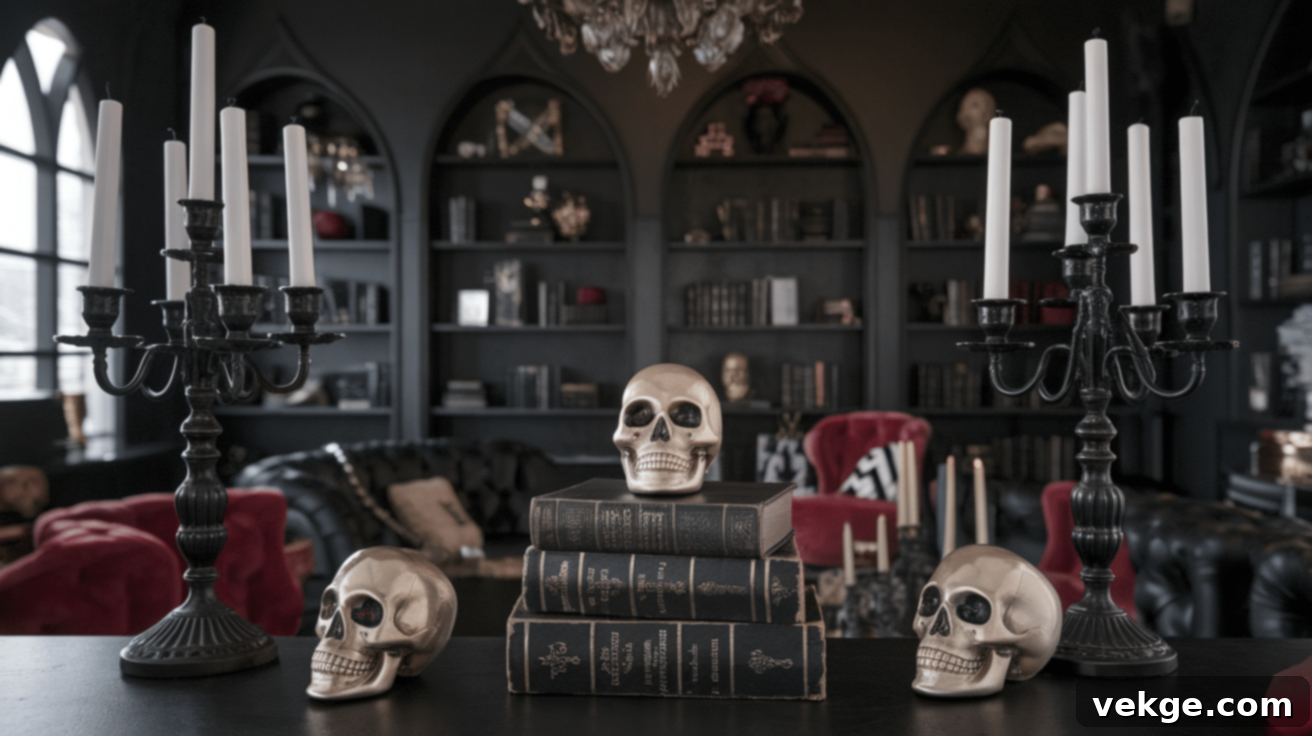
Small, carefully chosen touches often make the biggest impact in gothic spaces, adding personality and authenticity. Think about incorporating skull-shaped items (subtly, not overtly Halloween-like), elegant black candelabras, and antique-looking statues or busts to adorn shelves and tables. Mix in a collection of leather-bound books, intriguing hourglasses, or a few bird figurines (like ravens or owls) for variety and narrative. These items subtly tell stories and create engaging talking points for guests. The key is balance: a few well-chosen, meaningful pieces will always work better than cluttering every surface with dark objects, maintaining an air of curated mystery.
11. Exposed Brick Walls

Bare, exposed brick walls introduce a raw, organic texture and incredible depth to a goth-inspired living room. The rough, unfinished look of brick pairs exceptionally well with dark, opulent furniture and moody color palettes, creating a compelling contrast. For an even more dramatic impact, consider painting some of the bricks black or a deep charcoal gray, which further emphasizes their texture while deepening the room’s atmosphere. This robust architectural element creates a perfect, authentic backdrop for displaying ornate gothic mirrors, striking artwork, and other captivating decorations, grounding the entire design in a sense of timeless strength.
12. Gothic Style Curtains
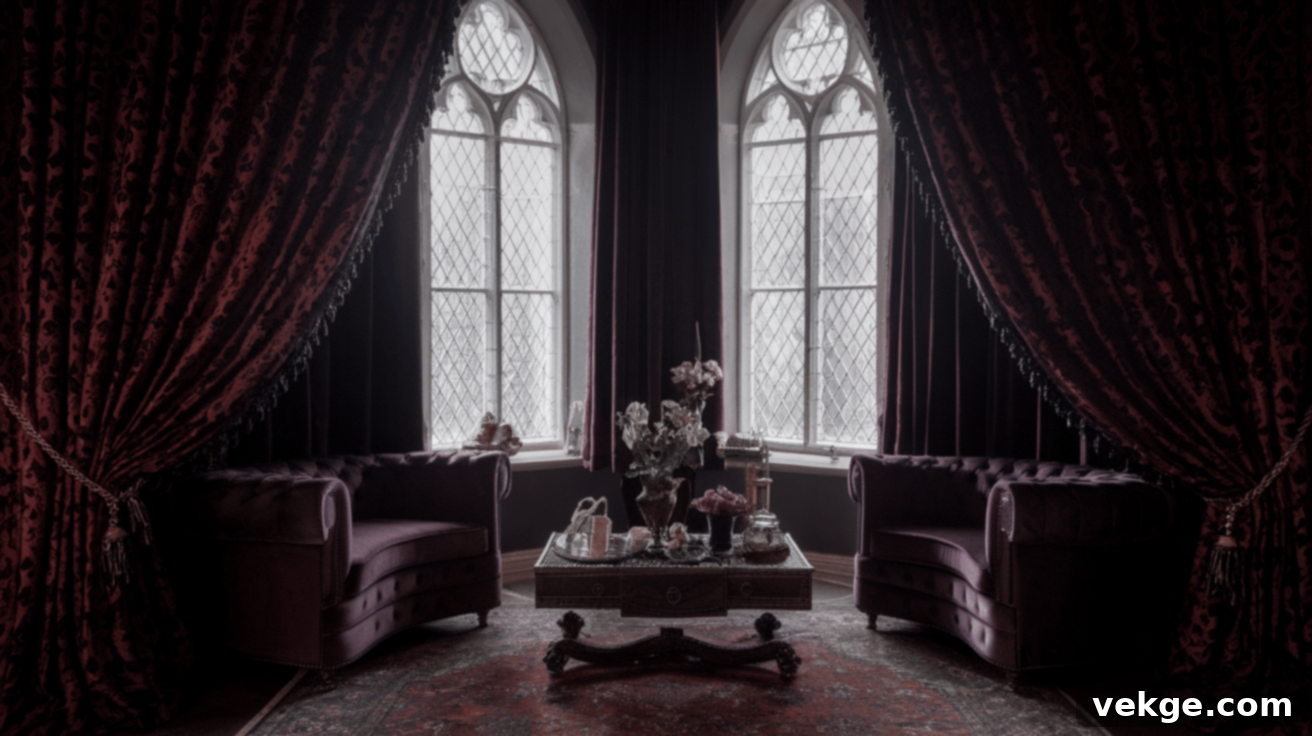
Heavy, luxurious curtains made of velvet, brocade, or rich damask fabrics instantly add weight, texture, and undeniable drama to any gothic living space. Deep, saturated colors such as burgundy, royal purple, or classic black are ideal for creating that desired moody atmosphere while effectively blocking out harsh light, preserving the shadowy ambiance. Opt for long, floor-length designs, perhaps with elegant tiebacks or intricate patterns, to complement the overall dark theme and infuse a touch of old-world charm into your windows. These curtains frame the outside world, creating a private, mysterious interior.
13. Use Lush Greenery
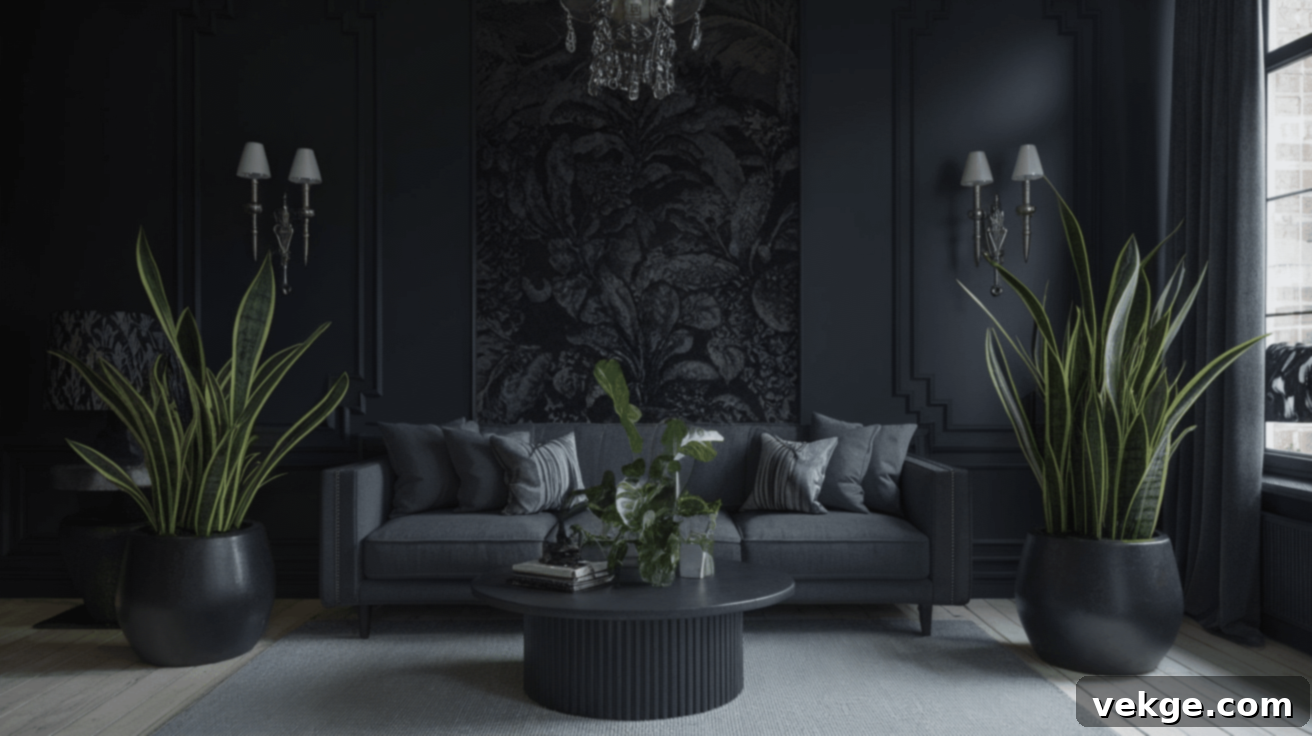
Potted plants with dark, deep green foliage bring a subtle hint of life and organic contrast to gothic living rooms without disrupting the moody aesthetic. Varieties like snake plants, black mondo grass, or dark-leafed begonias thrive against dim backdrops, their rich greens providing a welcome splash of natural color. Their vibrant tones create a pleasing contrast with black furniture and walls, softening the overall look of the space with refreshing natural elements. Greenery breathes life into the solemnity of gothic design, creating a sense of growth amidst the drama.
14. Gothic Furniture with Curved Lines
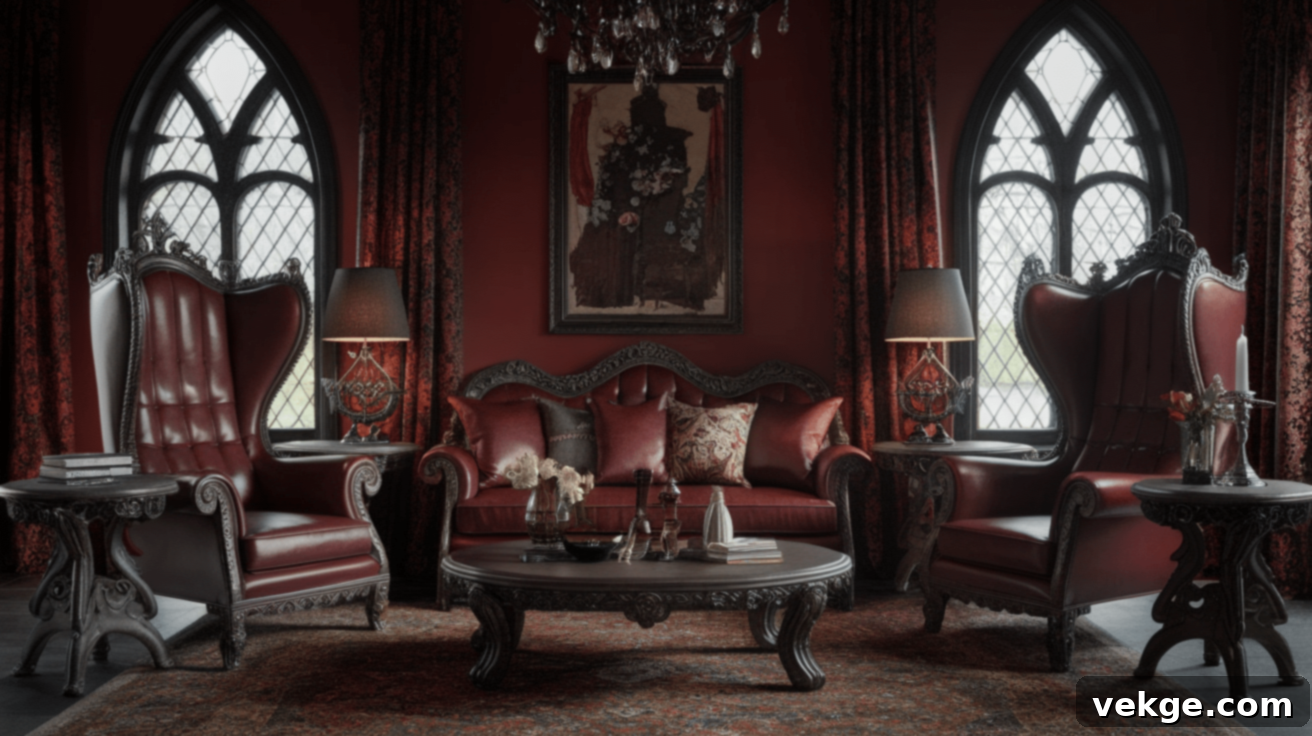
Furniture featuring ornate curves, elegant arches, and intricate carved details truly embodies the heart of Gothic design. Seek out chairs, tables, and cabinets with graceful twists, pointed arches, or elaborate scrollwork that immediately catch the eye. High-backed chairs, wooden pieces adorned with detailed carvings, and metal items with twisting, organic forms all fit perfectly within this style. These standout pieces are not just functional; they become significant focal points, defining the aesthetic of your dark-themed living space and adding a sense of historical grandeur and artistic flair.
15. Mix Modern and Antique Pieces
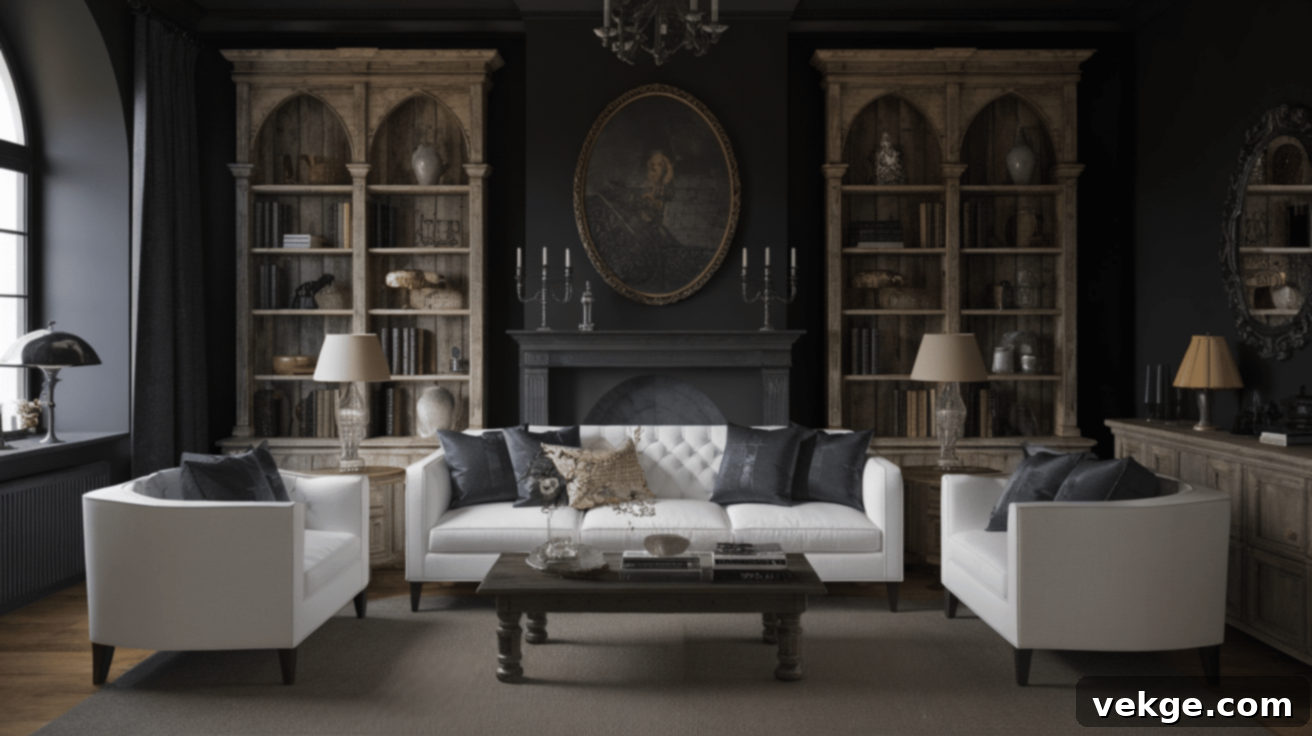
Blending new, sleek items with cherished antiques is key to creating a modern gothic space that feels both current and delightfully timeless. Try pairing a contemporary, clean-lined sofa with an aged, richly detailed wooden bookcase or a vintage brass lamp. This deliberate mix works best when you maintain a consistent color palette – dark modern pieces complementing worn antiques in similar deep shades. The intriguing contrast between clean, minimalist lines and intricate, aged details adds significant depth and a compelling narrative to your living room’s story, reflecting a sense of curated history.
16. Creepy Candles and Candleholders
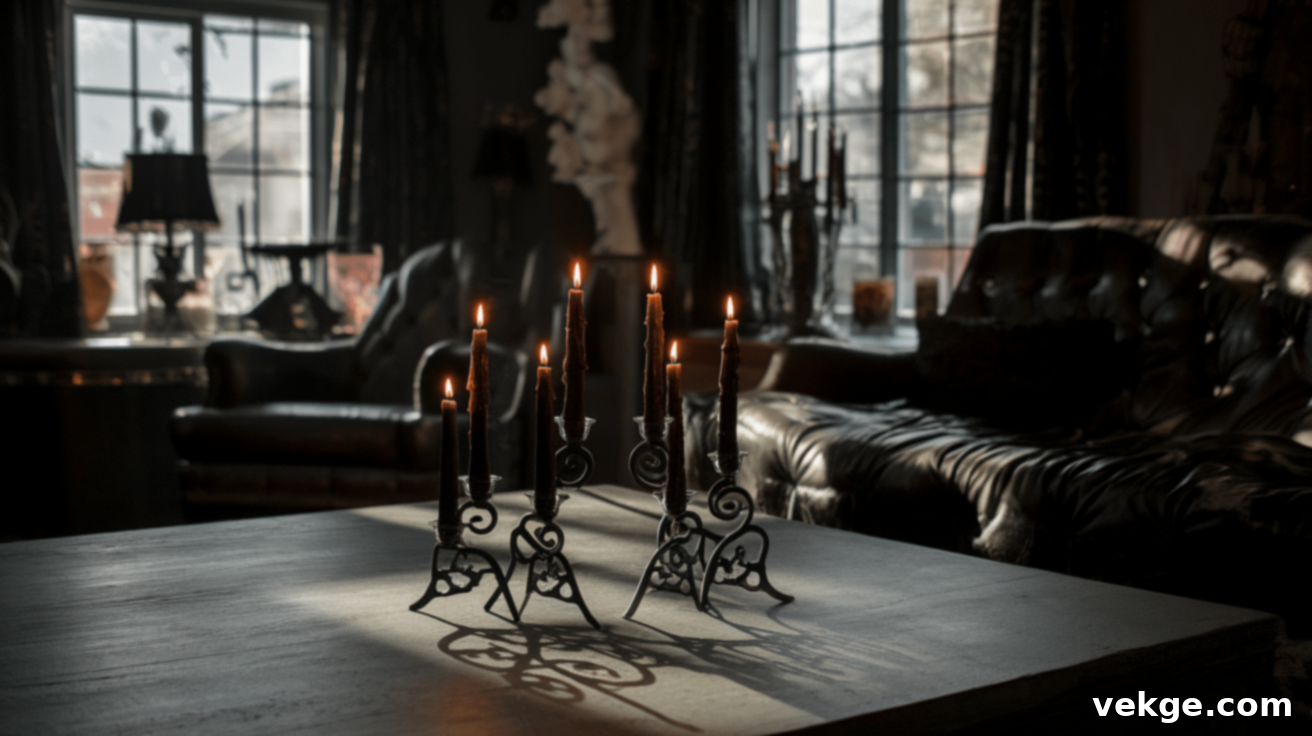
Black candles and unusually shaped holders are perfect for cultivating the ideal moody and atmospheric ambiance for your gothic living room. Look for skull-shaped stands, metal holders with twisted, organic designs, or dramatic tall black pillar candles. Arranging these in groups at varying heights adds depth and allows shadows to dance evocatively on the walls, enhancing the mystique. Even when unlit, these pieces serve as striking, conversation-starting decorations that subtly hint at dark tales and arcane charm, enriching the overall gothic narrative of your space.
17. Vintage Rugs with Dark Patterns

Dark-toned rugs featuring detailed, often faded patterns introduce warmth, softness, and historical depth to a gothic living room while maintaining its signature moody feel. Seek out rugs in deep red, black, rich purple, or deep blue with complex, ornate designs or subtly worn edges that suggest age and a storied past. These luxurious floor coverings bring essential comfort underfoot and elegantly tie together the room’s various dark elements. Their soft texture also provides a welcome balance to the harder surfaces often found in gothic furniture and exposed brick walls, grounding the design with a sense of comfort.
18. Gothic Color Blocking
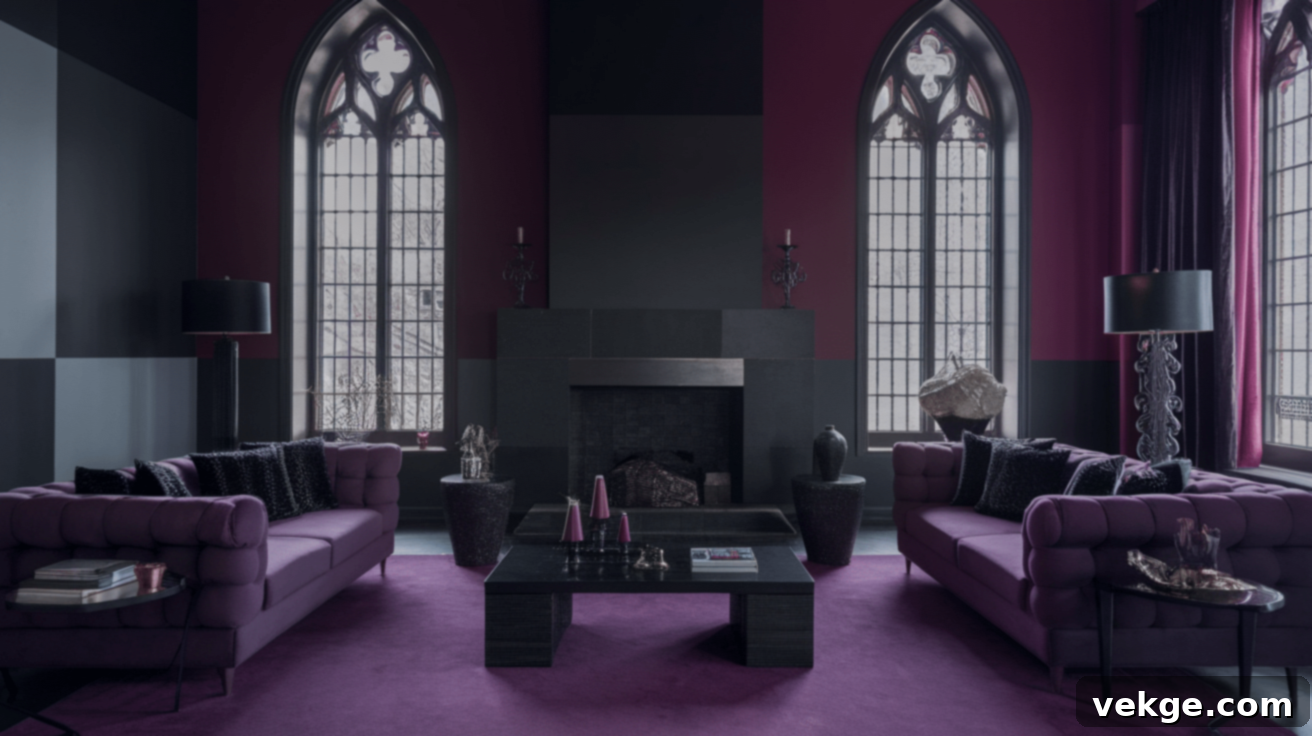
Employing blocks of deep, saturated colors next to each other creates a distinctly modern take on the gothic style, adding structure and visual interest. Try pairing stark black walls with a lush dark purple velvet sofa, or deep gray floors with a burgundy area rug. To intelligently break up the intensity of the dark tones, strategically add metallic items in silver, copper, or antique gold. This color-blocking method gives each color area a clear, deliberate purpose, making the room feel thoughtfully planned and distinctly current, while still preserving that moody and dramatic gothic essence.
19. Metallic Accents
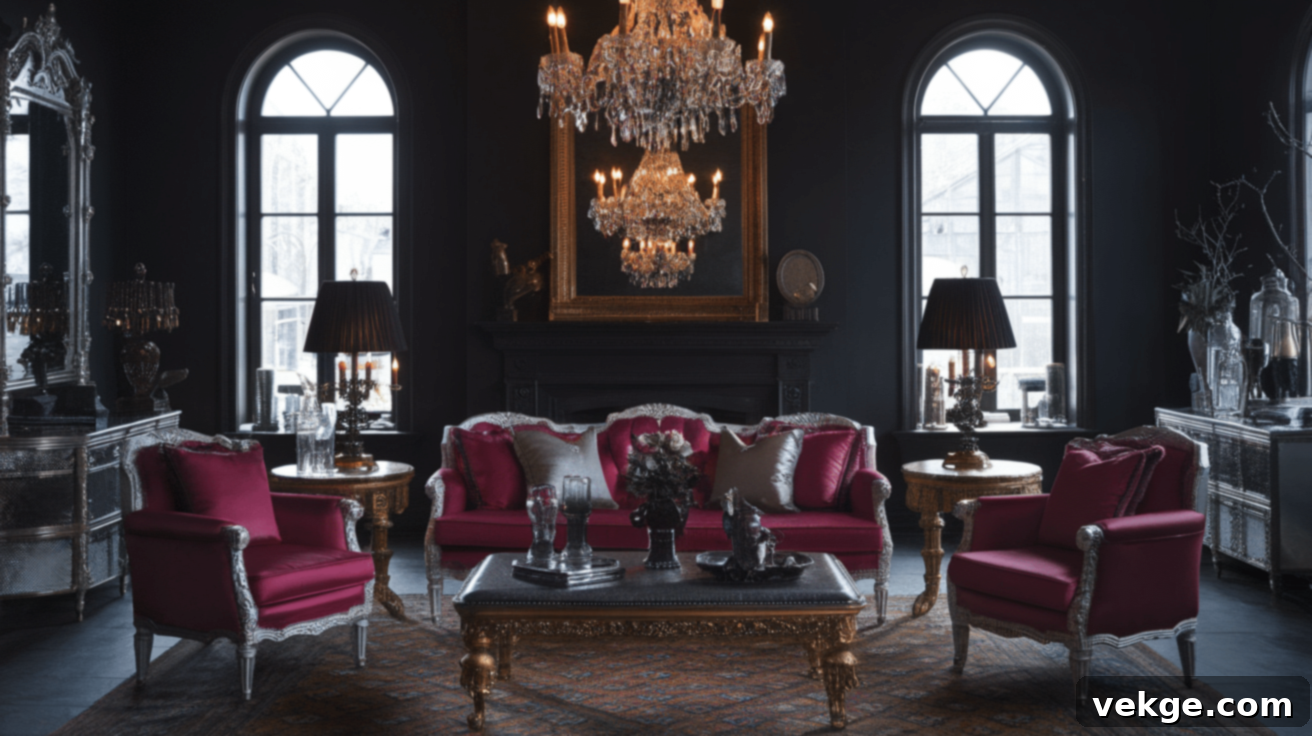
Strategic gold or silver touches on key pieces are indispensable for adding a layer of opulence and richness to gothic living rooms. Metal frames around mirrors, lamp bases with a subtle sheen, or furniture featuring elegant metal legs all bring a much-needed glimmer to otherwise dark spaces. These bright, reflective spots expertly catch the light, standing out magnificently against black or deeply colored walls. For a more authentic and understated gothic look, opt for worn or brushed metals that convey a sense of age and history rather than a brand-new, overly polished finish, adding character and depth.
20. Gothic-inspired Wall Art and Tapestries
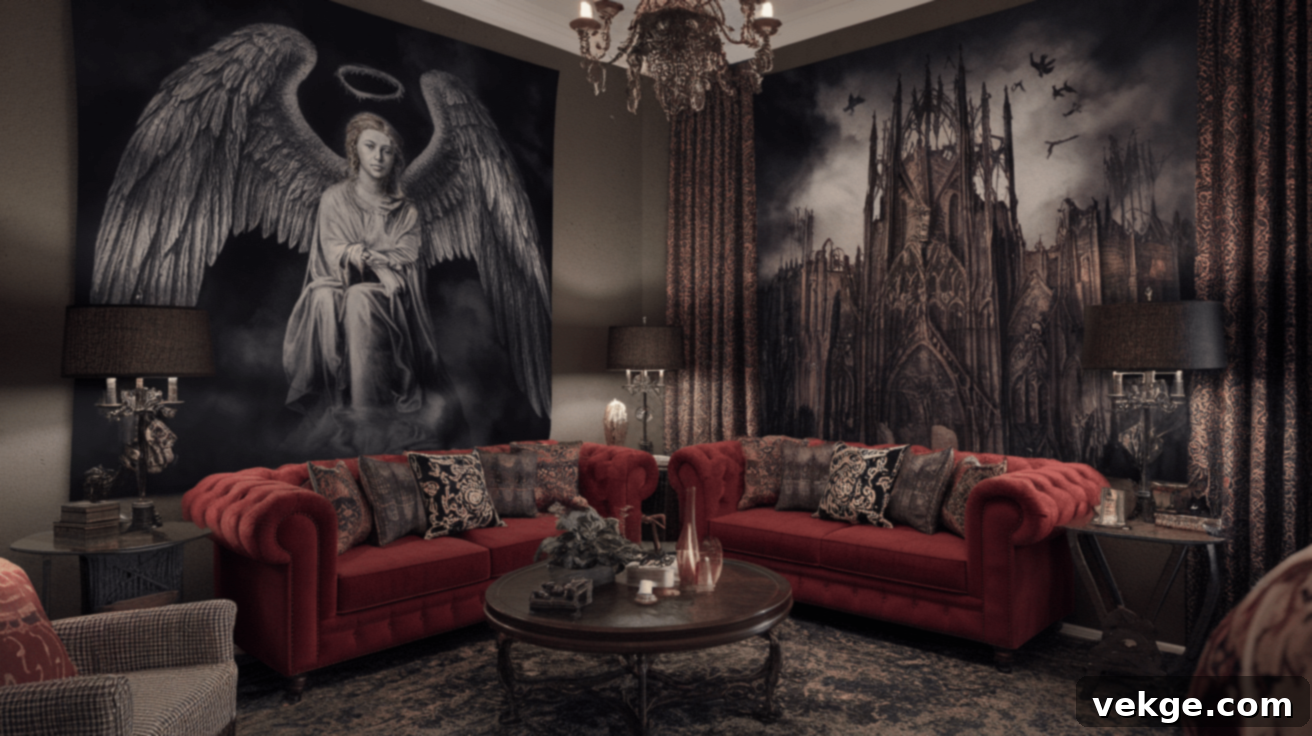
Large, dramatic wall hangings and tapestries with gothic themes make profound statements in a moody living room, transforming bare walls into storytelling canvases. Search for grand canvas prints or richly woven cloth tapestries depicting dark angels, mythical creatures, ancient cathedrals with towering spires, or mysterious landscapes. These impressive art pieces not only fill large wall spaces but also add depth and narrative to your room. Furthermore, the varying textures from canvas or woven fabrics significantly help to soften acoustic echoes in spaces featuring hard surfaces like wood floors and exposed brick walls, enhancing both visual and auditory comfort.
21. Faux Fur Throws
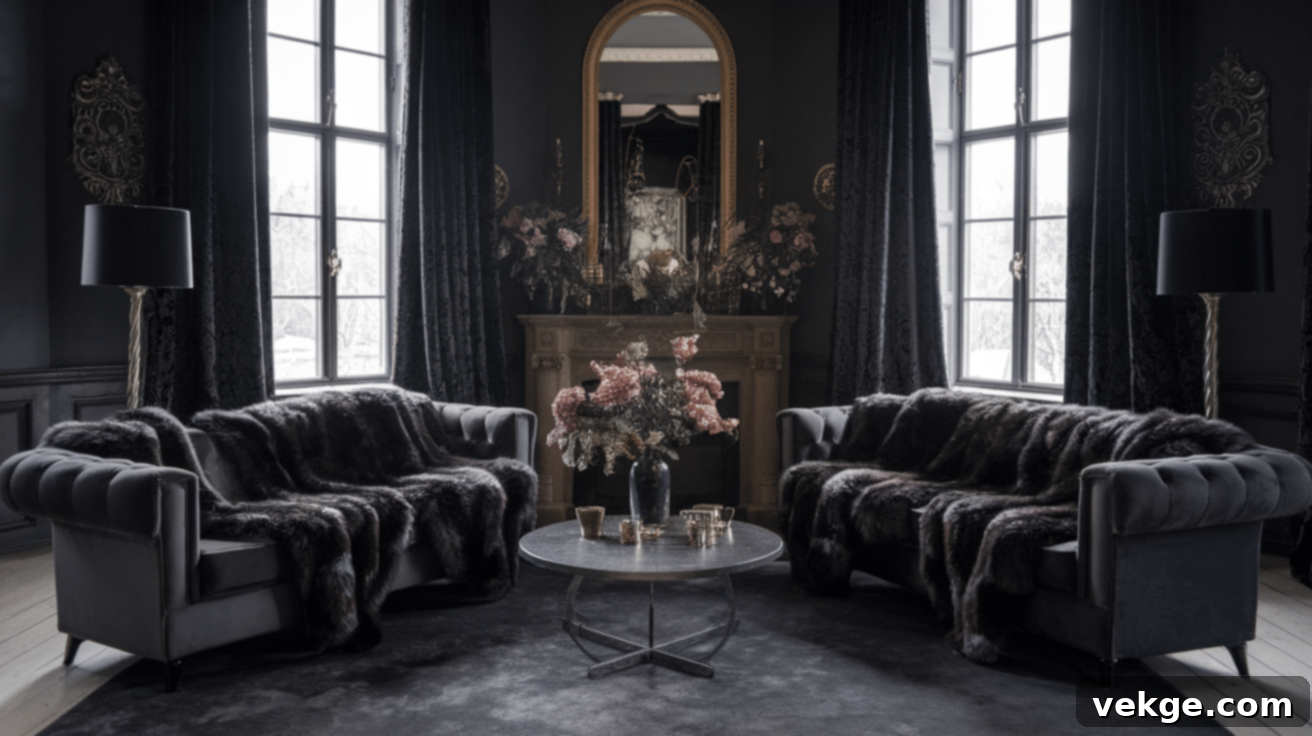
Dark faux fur throws and plush pillows bring an undeniable sense of luxurious comfort and tactile style to a gothic living room. Furs in black, deep purple, or dark gray add a rich, inviting texture that simply begs to be touched, enhancing the cozy factor. Drape these decadent throws casually over the back of sofas or chairs for easy access on cool evenings, or arrange them on the floor by a fireplace. These soft, opulent items make the room feel wonderfully lived-in and warm, beautifully balancing the cooler, harder surfaces often found in gothic designs, such as metal, stone, and dark wood.
22. Industrial Lighting Fixtures
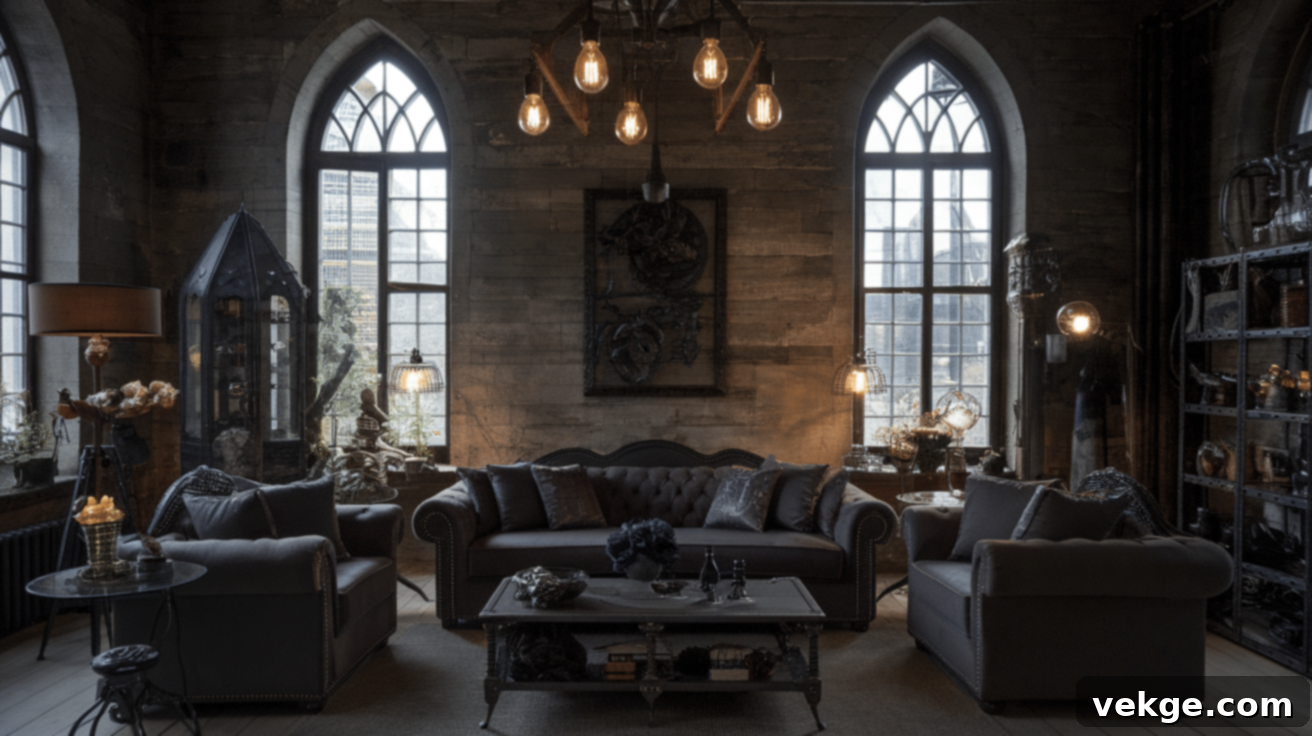
Robust metal light fixtures, especially those with exposed bulbs or cage designs, fit remarkably well into modern gothic spaces, bridging the gap between historical drama and contemporary edge. Choose black iron or copper lamps with visible wiring or sturdy chain supports to evoke a sophisticated workshop or dungeon-esque feel. Wall sconces with dark metal arms or multi-bulb hanging lights can strategically create inviting pools of warm light in darker corners. These rugged, utilitarian fixtures introduce modern touches while perfectly complementing the bold, structured look inherent in gothic design, adding both function and powerful aesthetics.
23. Gothic Bookshelves
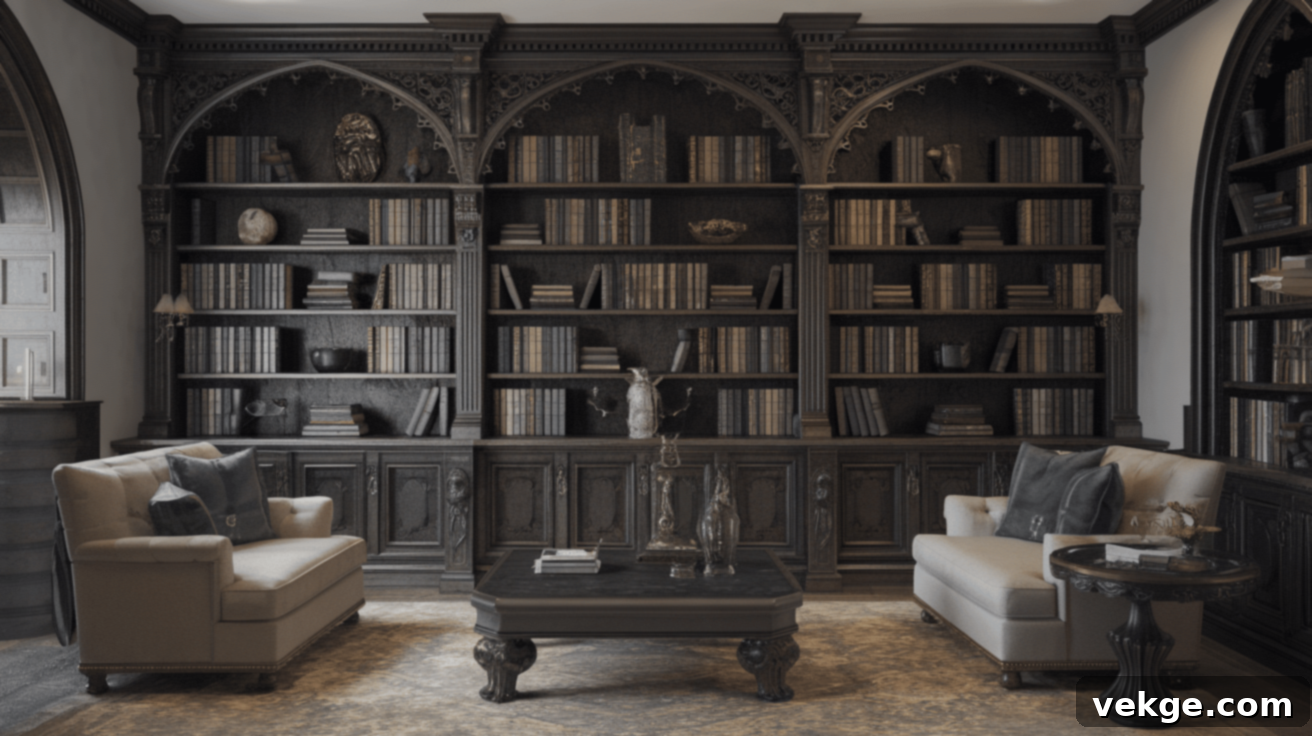
Dark wooden bookshelves, particularly those with carved details or pointed arches, make perfect, atmospheric homes for both literary collections and curated decorative items in a gothic living room. Look for tall units that impressively reach towards the ceiling, drawing the eye upward and adding vertical grandeur to the space. Shelves with black finishes, intricate molding, or built-in cabinet doors feel as though they belong in ancient, storied homes. Fill them thoughtfully with leather-bound books, dark decorative containers, and a few intriguing, antique-like curiosities to complete the scholarly and mysterious look.
24. Lace or Sheer Fabrics
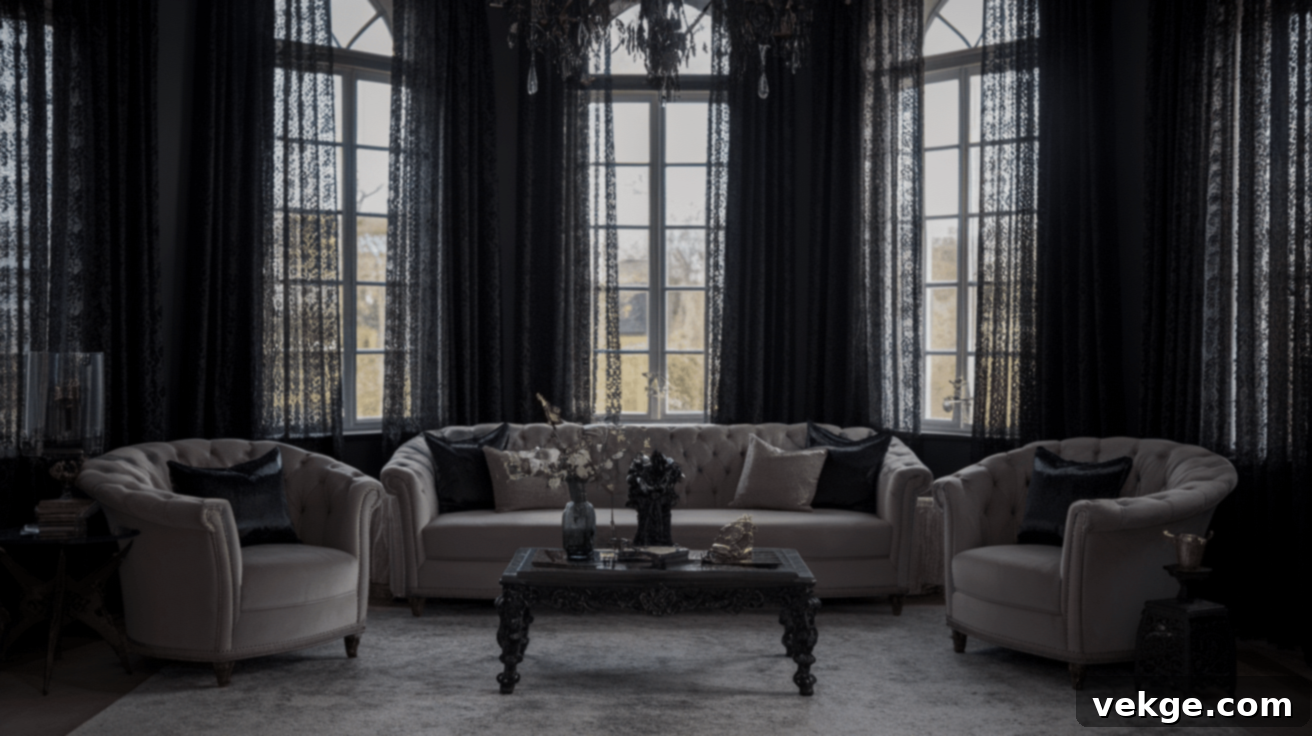
Delicate black lace or sheer curtains introduce a subtle layer of depth and alluring mystery to your gothic living room. When natural light gently filters through these ethereal materials, it creates soft, intricate shadows and beautiful patterns on your walls and floors, adding to the room’s dynamic visual texture. You can also incorporate lace into tablecloths, throw pillow covers, or smaller wall hangings to bring in more intricate texture without making the room feel heavy, crowded, or overtly dark. These fabrics offer a touch of refined elegance and a hint of the past, softening the bold elements.
25. Dark Accent Walls with Wallpaper
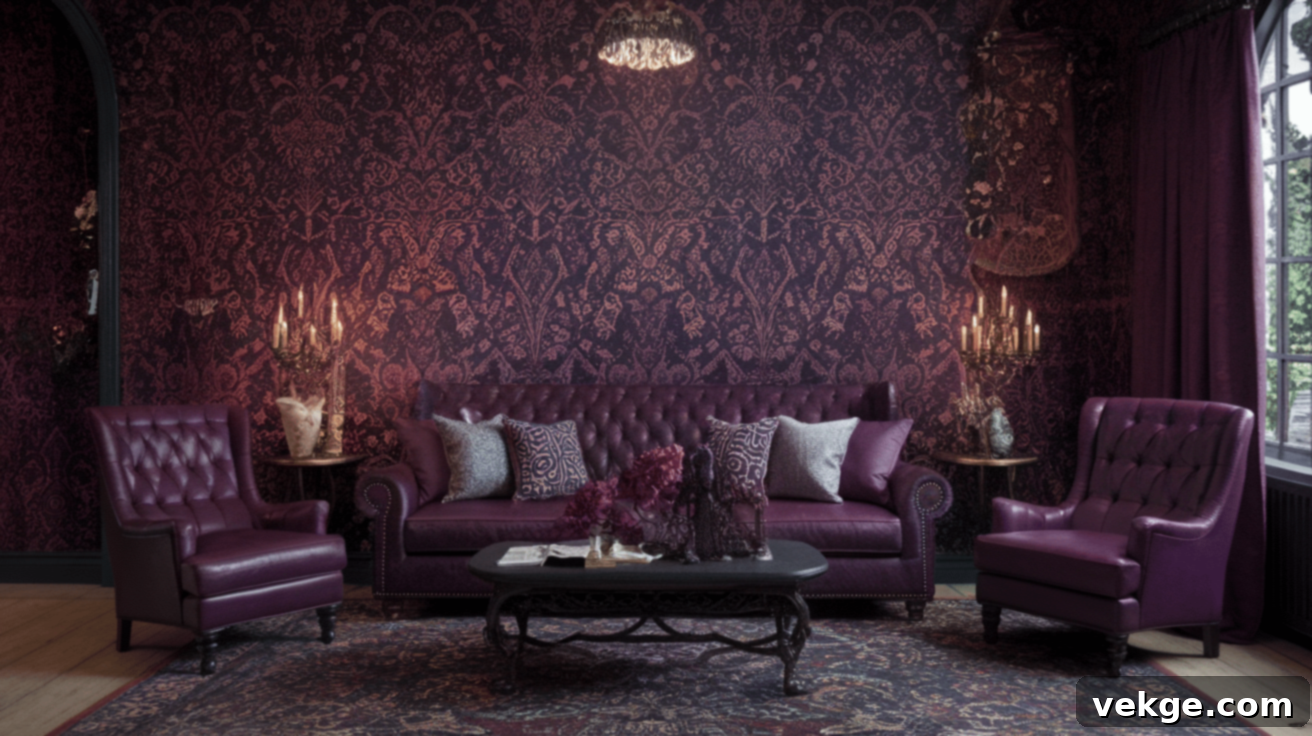
A single wall adorned with deep-colored, patterned wallpaper can effortlessly become the dramatic focal point of your gothic living room. Search for designs featuring classic damask patterns, intricate Victorian motifs, or elegant floral prints in shades of black, deep purple, or rich burgundy. This adds significant visual interest and luxurious texture without making the entire space feel overly dim or oppressive. To maintain balance, keep the other walls in lighter, contrasting shades such as deep gray, charcoal, or even a soft cream. This contrast helps to balance the overall mood and prevent the room from feeling too enclosed.
26. Create a Gallery Wall
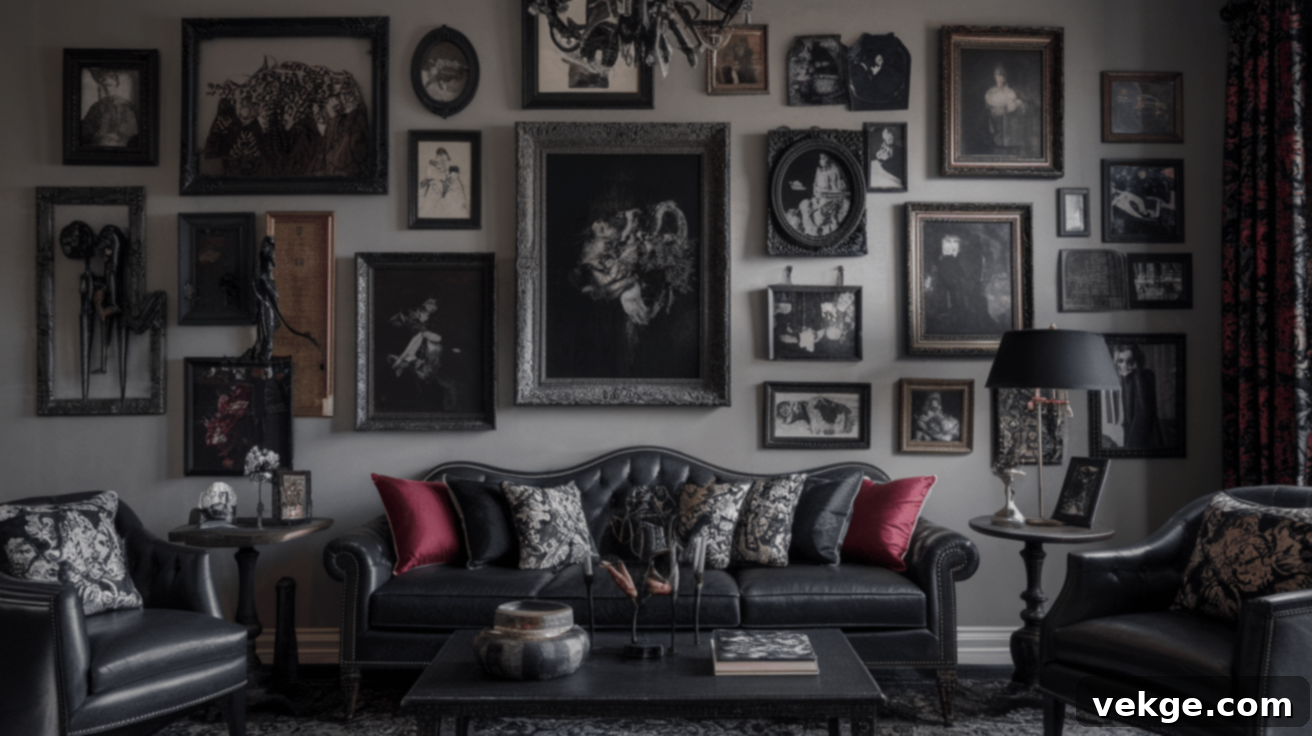
A thoughtfully curated collection of moody artwork, presented in varied frames, creates a deeply personal and artistic touch in your gothic living room. Mix ornate black or dark metallic frames with simpler ones, holding dark-themed art prints, antique maps, or vintage monochrome photos. Arrange them in an eye-catching, asymmetric layout that draws attention and tells a cohesive story. Black and white family photos can blend seamlessly with gothic prints, adding a meaningful and nostalgic layer to your wall design, personalizing the grand aesthetic without sacrificing the theme.
27. Antique-Inspired Clocks

Old-style clocks with dark wood or intricate metal frames fit perfectly into the historical narrative of a gothic living room. Look for striking wall clocks featuring classic Roman numerals, elegant carved details, or mesmerizing pendulums that capture the eye. Mantel clocks on a fireplace or imposing standing grandfather clocks add both height and an irresistible old-world charm, acting as functional sculptures. These timepieces bring not only practical utility but also significant style, contributing to the room’s historical feel without unnecessary clutter, subtly reminding of the passage of time.
28. Gothic-Inspired Coffee Tables
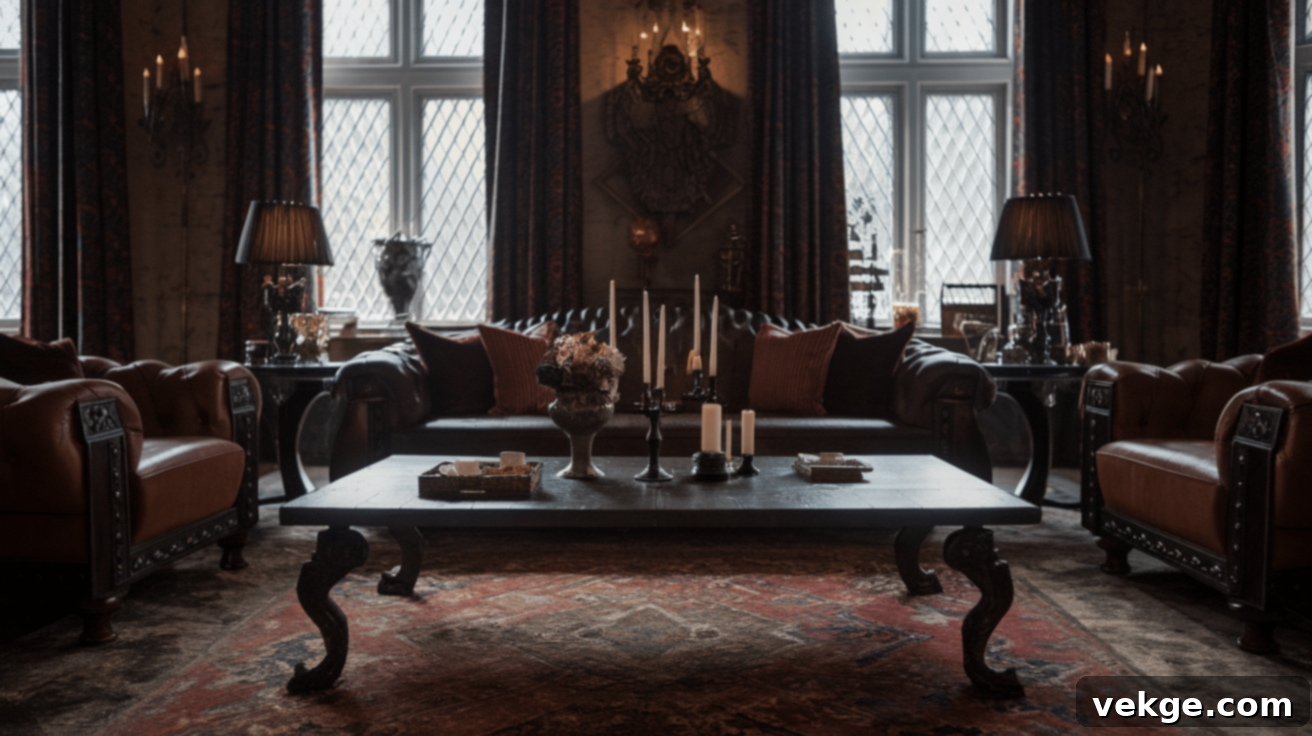
Coffee tables featuring carved legs, intricate dark metalwork, or unique shapes can become sophisticated standout pieces in gothic living rooms. Seek out tables in deep ebony, rich mahogany, or classic black finishes, often adorned with detailed patterns, claw feet, or elegant scrollwork. Glass tops paired with dark metal bases offer a delightful mix of old-world charm and modern transparency, providing lightness. These tables are not merely functional surfaces for drinks and books but also central elements that bring the right amount of gothic elegance and dramatic flair to your main seating area, grounding the space.
29. Dark Wood Flooring
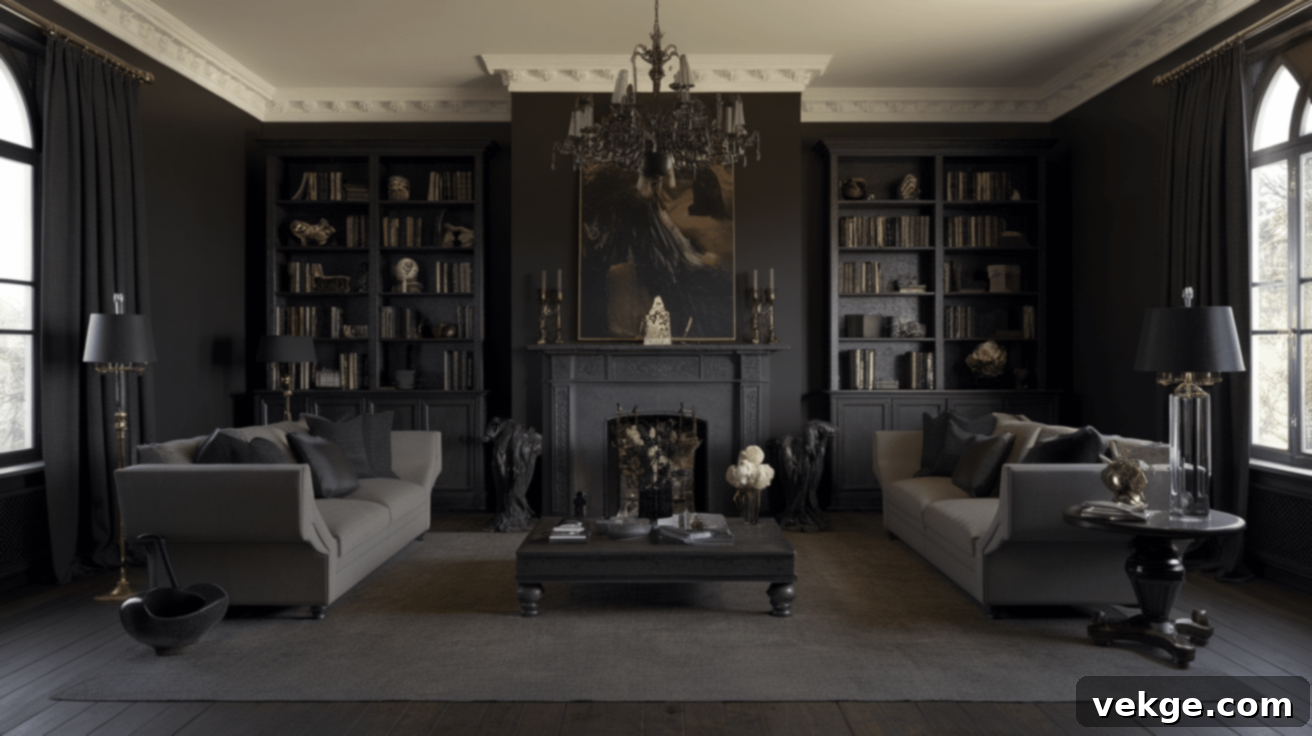
Dark oak, rich walnut, or deep ebony floors create a solid, sophisticated base for a gothic living room. The profound, deep tones of these woods add a natural warmth and luxurious feel while perfectly aligning with the moody, dramatic theme. These floors pair exceptionally well with area rugs in deep red, royal purple, or charcoal gray, introducing extra comfort and color. If genuine wood isn’t a feasible option, many high-quality vinyl or laminate alternatives offer a similar aesthetic at a more accessible price point. The strategic contrast between dark floors and lighter walls helps to prevent the room from feeling too small or enclosed, adding depth and elegance.
30. Add Antique Mirrors with Gothic Frames

Large, commanding mirrors featuring detailed black or rich metallic frames make bold and impactful statements in gothic living rooms. They not only visually expand the space by reflecting light and views but also serve as magnificent pieces of art in their own right. Look for mirrors with pointed arches, intricate carvings, or subtly aged glass for an authentic, time-worn feel. Position them strategically above fireplaces, over consoles, or on prominent walls where they can catch movement and light, adding depth, a sense of grandeur, and a hint of intriguing mystery to your room’s overall aesthetic, enhancing its enchanting allure.
31. Add Dark Metallic Furnishings

Black iron side tables, elegant brass lamps, or antique bronze candleholders introduce a rich, compelling contrast and an industrial edge to gothic living rooms. These metal pieces work wonderfully against plush velvet chairs or lighter-colored walls, creating visual tension and interest. Seek out items with delicate scrollwork, intricate patterns, or hammered textures that beautifully catch and play with the light. A metal shelving unit or even a striking industrial-style chandelier can become a significant room highlight. These hard-wearing materials add lasting style while bringing a tough, timeless quality and an element of refined strength to the space, balancing softness with rigidity.
How to Balance Dark and Light in a Modern Gothic Living Room
Creating a truly successful modern gothic living room hinges on achieving a delicate yet impactful balance between dark and light elements. This prevents the space from feeling too gloomy or overwhelming, ensuring it remains inviting and comfortable.
- Start with a Lighter Base: Consider painting your walls in softer shades like a muted cream, a warm gray, or even a very light charcoal. This provides a gentle backdrop against which dark furniture and decor can truly pop and make a statement.
- Strategic Use of Mirrors: Incorporate large, ornate mirrors not just for their aesthetic appeal, but also for their practical ability to reflect and bounce natural and artificial light around the room, making it feel brighter and more expansive.
- Introduce Bright Accents: Add elements of white, silver, or even light gold through throw pillows, delicate picture frames, white floral arrangements, or sheer curtain panels. These lighter accents provide crucial visual breaks and prevent dark corners from feeling heavy.
- Sheer or Semi-Sheer Curtains: Instead of heavy drapes everywhere, use sheer or semi-sheer curtains on some windows. They allow natural light to filter in gently while still maintaining the room’s moody atmosphere and providing privacy.
- Incorporate Greenery: As mentioned, potted plants with dark green foliage bring a vibrant, organic element that breaks up dark areas and adds a touch of life and freshness, contributing to the overall balance and warmth of the space.
Conclusion
Designing a modern gothic living room is an exciting journey into a world where dramatic aesthetics meet contemporary comfort. By thoughtfully mixing deep, rich colors with strategic lighter elements and opulent textures, you can create a space that feels both undeniably bold and wonderfully comfortable. Utilize key pieces such as intricately carved furniture, grand statement mirrors, and moody artwork to effectively set the desired tone and narrative.
Always remember that modern gothic isn’t about creating a cold or unwelcoming environment; it’s about crafting a space that possesses profound depth, sophisticated character, and a unique personality through deliberate and thoughtful design choices. With the right blend of luxurious textures, shimmering metallic accents, and carefully layered lighting, your modern gothic living room will not only become a compelling reflection of your individual style but also a truly inviting sanctuary that captivates and charms every guest. The ultimate result is a room with an unforgettable personality that boldly stands out from conventional designs, a testament to your distinctive taste. We encourage you to comment below and share how you used these inspiring ideas to design a magnificent gothic room for your own house!
